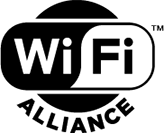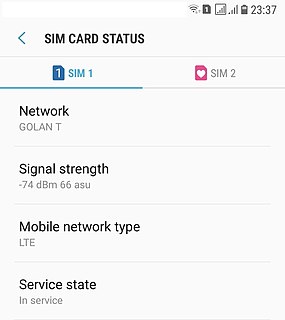Related Research Articles

IEEE 802.11 is part of the IEEE 802 set of local area network (LAN) protocols, and specifies the set of media access control (MAC) and physical layer (PHY) protocols for implementing wireless local area network (WLAN) Wi-Fi computer communication in various frequencies including, but not limited to, 2.4 GHz, 5 GHz, 6 GHz, and 60 GHz frequency bands.

A wireless network is a computer network that uses wireless data connections between network nodes.

Carrier-sense multiple access with collision avoidance (CSMA/CA) in computer networking, is a network multiple access method in which carrier sensing is used, but nodes attempt to avoid collisions by beginning transmission only after the channel is sensed to be "idle". When they do transmit, nodes transmit their packet data in its entirety.

Wi-Fi is a family of wireless network protocols, based on the IEEE 802.11 family of standards, which are commonly used for local area networking of devices and Internet access. Wi‑Fi is a trademark of the non-profit Wi-Fi Alliance, which restricts the use of the term Wi-Fi Certified to products that successfully complete interoperability certification testing. As of 2017, the Wi-Fi Alliance consisted of more than 800 companies from around the world. As of 2019, over 3.05 billion Wi-Fi enabled devices are shipped globally each year. Devices that can use Wi-Fi technologies include personal computer desktops and laptops, smartphones and tablets, smart TVs, printers, smart speakers, cars, and drones.

In computer networking, a wireless access point (WAP), or more generally just access point (AP), is a networking hardware device that allows other Wi-Fi devices to connect to a wired network. As a standalone device, the AP may have a wired connection to a router, but, in a wireless router, it can also be an integral component of the router itself. An AP is differentiated from a hotspot which is a physical location where Wi-Fi access is available.

WiMAX is a family of wireless broadband communication standards based on the IEEE 802.16 set of standards, which provide multiple physical layer (PHY) and Media Access Control (MAC) options.

A mesh network is a local network topology in which the infrastructure nodes connect directly, dynamically and non-hierarchically to as many other nodes as possible and cooperate with one another to efficiently route data from/to clients. This lack of dependency on one node allows for every node to participate in the relay of information. Mesh networks dynamically self-organize and self-configure, which can reduce installation overhead. The ability to self-configure enables dynamic distribution of workloads, particularly in the event a few nodes should fail. This in turn contributes to fault-tolerance and reduced maintenance costs.

In telecommunications, received signal strength indicator (RSSI) is a measurement of the power present in a received radio signal.
IEEE 802.11n-2009 or 802.11n is a wireless-networking standard that uses multiple antennas to increase data rates. The Wi-Fi Alliance has also retroactively labelled the technology for the standard as Wi-Fi 4. It standardized support for multiple-input multiple-output, frame aggregation, and security improvements, among other features, and can be used in the 2.4 GHz or 5 GHz frequency bands.
IEEE 802.12y-2008 is an amendment to the IEEE 802.12-2007 standard that enables data transfer equipment to operate using the 802.11a protocol on a co-primary basis in the 3650 to 3700 MHz band except when near a grandfathered satellite earth station. IEEE 802.12y is only being allowed as a licensed band. It was approved for publication by the IEEE on September 26, 2008.
Long-range Wi-Fi is used for low-cost, unregulated point-to-point computer network connections, as an alternative to other fixed wireless, cellular networks or satellite Internet access.
IEEE 802.11 – or more correctly IEEE 802.11-1997 or IEEE 802.11-1999 – refer to the original version of the IEEE 802.11 wireless networking standard released in 1997 and clarified in 1999. Most of the protocols described by this early version are rarely used today.
IEEE 802.11b-1999 or 802.11b is an amendment to the IEEE 802.11 wireless networking specification that extends throughput up to 11 Mbit/s using the same 2.4 GHz band. A related amendment was incorporated into the IEEE 802.11-2007 standard.
IEEE 802.11g-2003 or 802.11g is an amendment to the IEEE 802.11 specification that operates in the 2.4 GHz microwave band. The standard has extended throughput to up to 54 Mbit/s using the same 20MHz bandwidth as 802.11b uses to achieve 11 Mbit/s. This specification under the marketing name of Wi-Fi has been implemented all over the world. The 802.11g protocol is now Clause 19 of the published IEEE 802.11-2007 standard, and Clause 19 of the published IEEE 802.11-2012 standard.
Wi-Fi positioning system is a geolocation system that uses the characteristics of nearby Wi-Fi hotspots and other wireless access points to discover where a device is located. It is used where satellite navigation such as GPS is inadequate due to various causes including multipath and signal blockage indoors, or where acquiring a satellite fix would take too long. Such systems include assisted GPS, urban positioning services through hotspot databases, and indoor positioning systems. Wi-Fi positioning takes advantage of the rapid growth in the early 21st century of wireless access points in urban areas.
WiFi-Where is a tool that facilitates detecting wireless LANs using the 802.11b, 802.11a and 802.11g WLAN standards. Versions exist for the operating systems iOS and Palm OS. Originally created in June 2004 for the Palm OS by Jonathan Hays of Hazelware Software, the IP for WiFi-Where was licensed to 3Jacks Software in 2009. An iPhone version of the application was released in January 2010, but was pulled from the App Store by Apple in March 2010. As of 2010, it is available in the Jailbroken Cydia store.
IEEE 802.11ac-2013 or 802.11ac is a wireless networking standard in the 802.11 set of protocols, providing high-throughput wireless local area networks (WLANs) on the 5 GHz band. The standard has been retroactively labelled as Wi-Fi 5 by Wi-Fi Alliance.
IEEE 802.11s is Wireless LAN standard and an IEEE 802.11 amendment for mesh networking, defining how wireless devices can interconnect to create a WLAN mesh network, which may be used for relatively fixed topologies and wireless ad hoc networks. The IEEE 802.11s working group draws upon volunteers from university and industry to provide specifications and possible design solutions for wireless mesh networking. As a standard, the document was iterated and revised many times prior to finalization.
IEEE 802.11k-2008 is an amendment to IEEE 802.11-2007 standard for radio resource measurement. It defines and exposes radio and network information to facilitate the management and maintenance of a mobile Wireless LAN. IEEE 802.11k was incorporated in IEEE Std 802.11-2012; see IEEE 802.11.
References
- ↑ "A Practical Approach to Identifying and Tracking Unauthorized 802.11 Cards and Access Points" (PDF). Archived from the original (PDF) on 2009-01-26. Retrieved 2009-07-08.
- ↑ "Wireless Triangulation Using RSSI Signals". Archived from the original on 2009-12-31. Retrieved 2009-07-08.
| | This article about wireless technology is a stub. You can help Wikipedia by expanding it. |